How To Reinforce Bed Frame? Tips and Tricks
Ever tried to get a good night’s sleep only to be interrupted by the unsettling creaking of your bed frame? If that sounds familiar, you’re not alone. A sturdy bed frame is vital for restful sleep, and overlooking the need for reinforcement can lead to a variety of issues, like sagging mattresses and annoying noises.
Why Reinforce a Bed Frame?
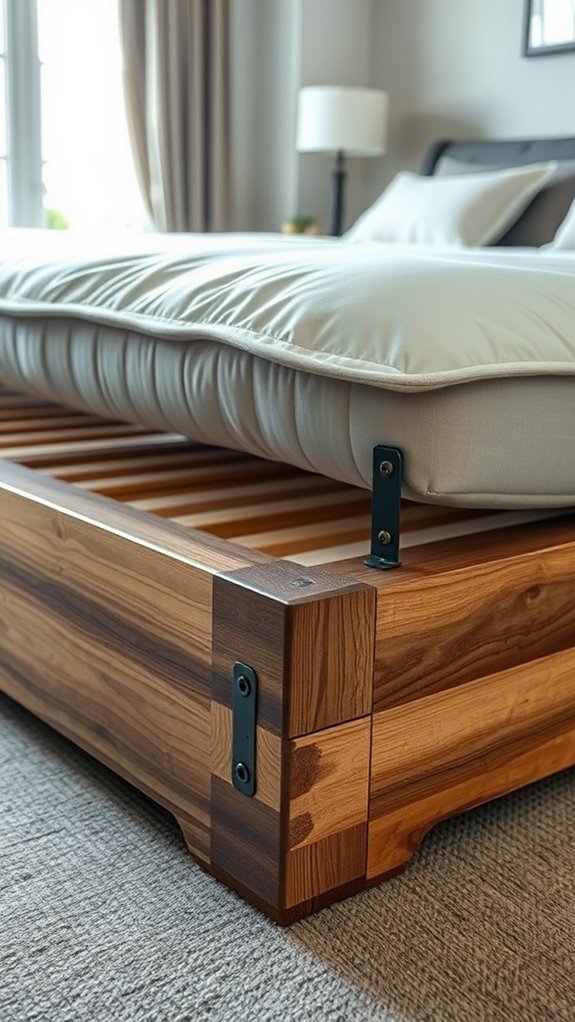
Reinforcing a bed frame is essential for anyone wanting a good night’s sleep.
Think of your bed frame as the unsung hero of your sleep sanctuary. Over time, it can develop loose joints and weakened support, which just won’t cut it for a restful night.
By reinforcing it, I boost its structural integrity, allowing it to handle the weight capacity of my mattress without sagging. This not only enhances stability but also elevates comfort—no more disruptive squeaks and creaks!
Plus, addressing wear and tear extends the lifespan of both my bed frame and mattress. It’s like giving my sleep setup a spa day, ensuring I wake up refreshed instead of feeling like I’ve wrestled a bear all night! Additionally, a reinforced bed frame can better support the weight capacity of the mattress, promoting a healthier sleep environment.
Signs Your Bed Frame Needs Reinforcement
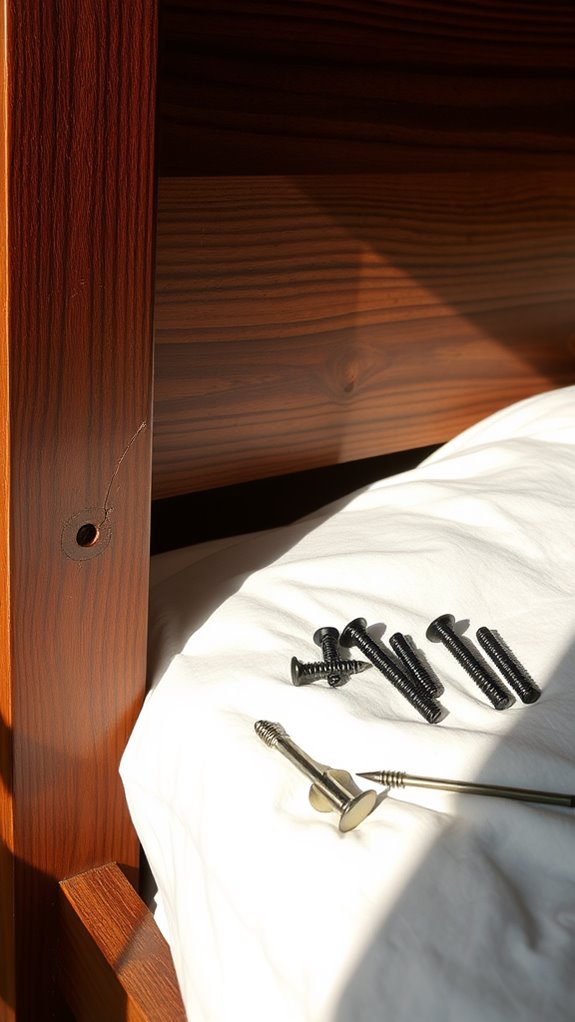
A sturdy bed frame is essential for a good night’s sleep, but how do you know when it’s time to give it some reinforcement?
First off, keep an eye out for visible damage like cracked slats or loose bolts. If your bed frame wobbles or creaks when you move, that’s a red flag waving for additional support.
I always inspect joints for any signs of weakened joints—trust me, structural failure isn’t a fun surprise.
And if your mattress is sagging like it’s auditioning for a drama role, it might mean your frame needs extra slats or a center beam.
Don’t forget to check for missing hardware; those tiny screws are the unsung heroes of stability and support!
Tools and Materials Needed for Bed Frame Reinforcement
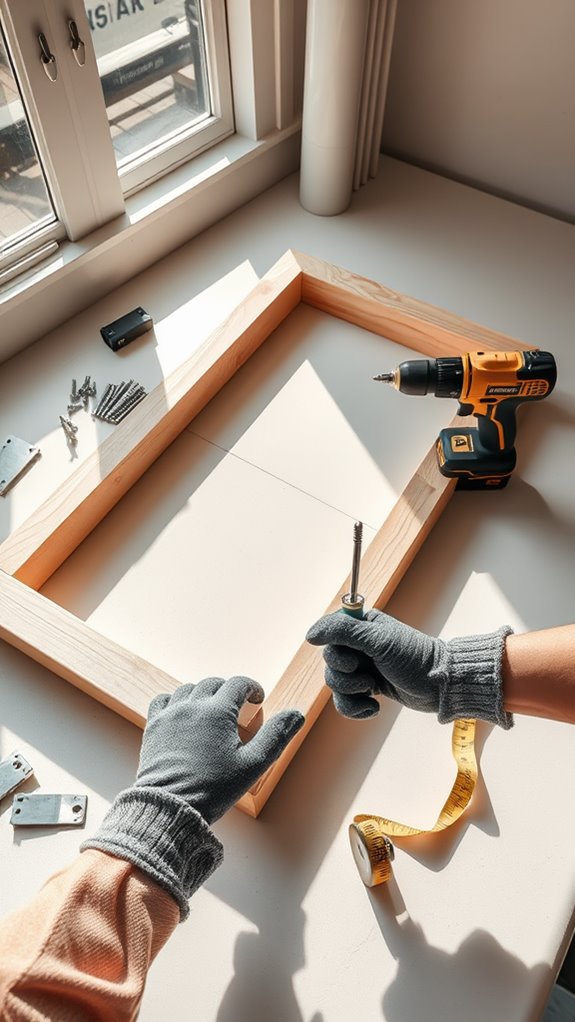
When it comes to reinforcing your bed frame, having the right tools and materials on hand makes all the difference.
Think of it like preparing for a DIY adventure; you wouldn’t head into battle without your trusty sword, would you?
Here’s what you’ll need:
- Basic Tools: A power drill, screwdriver set, measuring tape, and leveler to guarantee everything’s aligned just right.
- Fasteners and Hardware: Stock up on screws, bolts, and metal brackets to fortify those joints.
- Support Materials: Consider adding wooden slats and a center support beam for extra stability.
Don’t forget wood glue to keep everything snug, and always wear safety goggles and protective gear to avoid any DIY mishaps.
Happy reinforcing!
How to Reinforce Bed Frame: Step-by-Step Guide
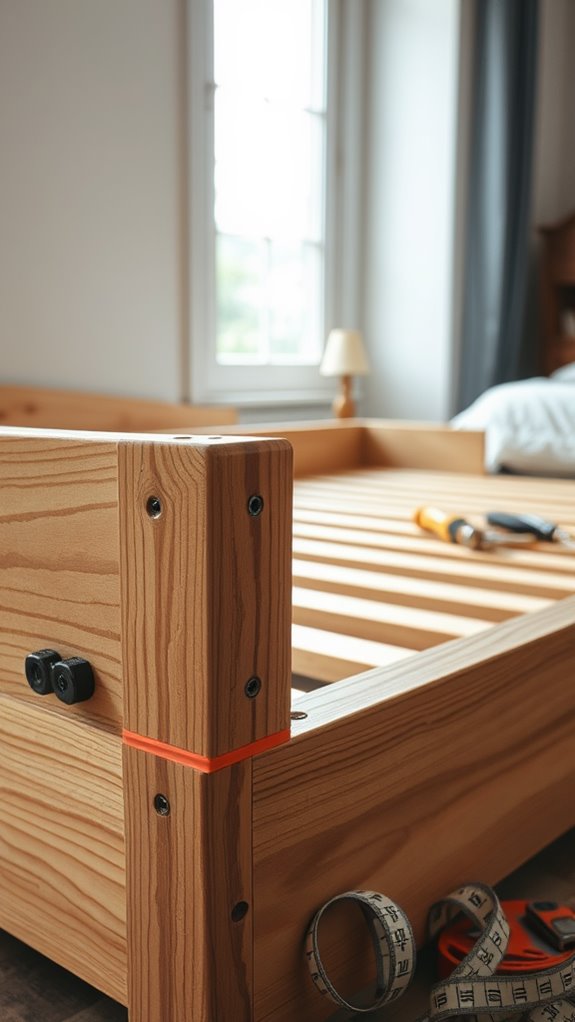
Alright, let’s get that bed frame feeling as sturdy as a rock.
First off, I’ll give it a good once-over for any cracks or loose bolts—think of it like a dental check-up, but for your bed.
Once I’ve tackled the obvious issues, I’m ready to roll up my sleeves and reinforce those slats, joints, and maybe even sneak in some plywood for extra support—because who wants a wobbly bed when they’re just trying to catch some Z’s?
Inspect the Bed Frame
Check the bed frame for damage, stability, and wear.
Document any weak spots and regularly inspect slats for sagging or cracking.
Reinforce the Slats
To reinforce bed slats, add sturdy extra slats, replace warped ones, use a drill for secure attachment, and install spacers for even spacing.
Strengthen the Joints
Inspect joints for wear, tighten screws, add metal braces, use wood glue, replace damaged wood, and regularly check for stability to reinforce your bed frame.
Add a Center Support Beam
To reinforce your bed frame, measure the width, buy a sturdy center support beam, and install it securely for added stability.
Use Plywood for Extra Support
Cut a 3/4-inch plywood piece to fit snugly on your bed frame, secure it with screws, and check regularly for wear.
Tighten All Screws and Bolts
Remove bedding and check for loose screws, bolts, and pins.
Tighten them securely without overtightening, focusing on joints.
Replace any missing fasteners.
Alternative Solutions for Bed Frame Reinforcement
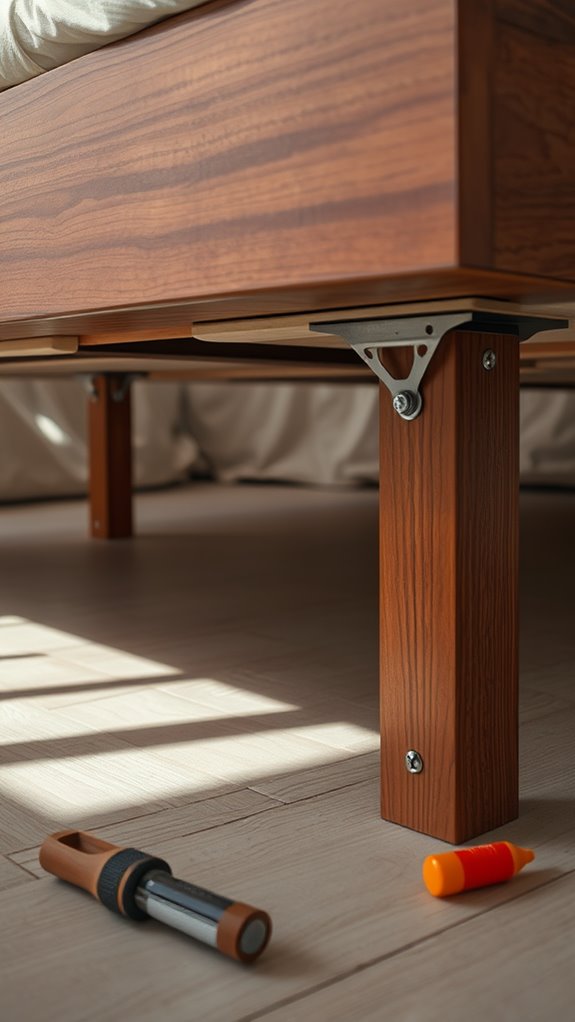
Reinforcing your bed frame can greatly improve its stability and longevity. If you’re tired of your bed creaking like an old ship, there are several clever alternatives to evaluate.
Here’s how to elevate your sleep experience:
- Use metal brackets or corner braces to reinforce joints and connections.
- Install a center support beam for added stability, especially for larger beds.
- Add extra support slats or a bunkie board to prevent sagging.
You can also utilize plywood reinforcement beneath your mattress to enhance weight distribution.
If you want to keep things steady, a wall anchor kit is a game changer for adjustable or metal frames.
With these solutions, you’ll transform your bed from a wobbly mess to a sturdy sanctuary. Sweet dreams await!
Maintenance Tips to Keep Your Bed Frame Sturdy
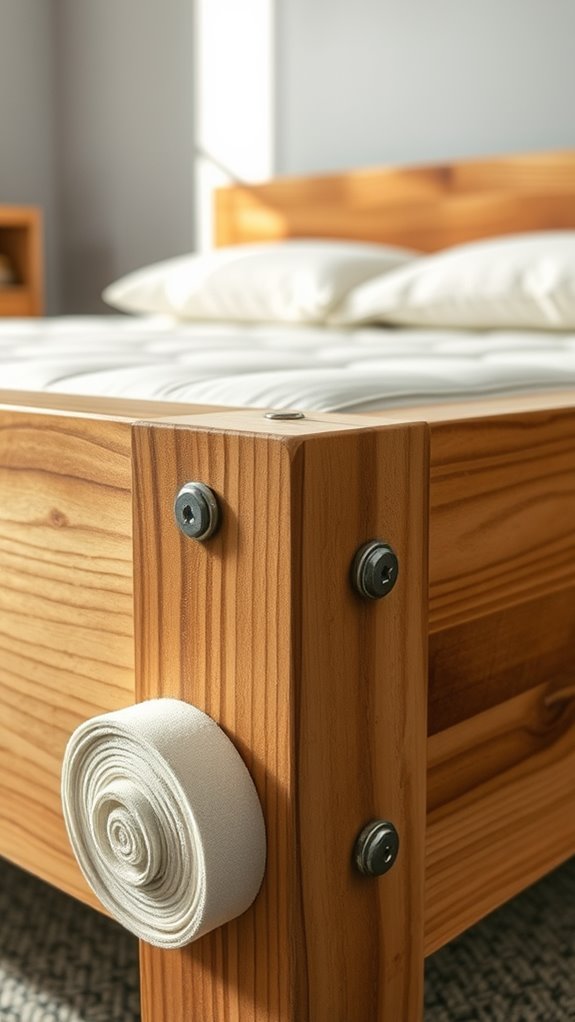
While you may think that your bed frame is sturdy enough, regular maintenance is essential to confirm it stays that way.
I’ve learned the hard way that a squeaky bed isn’t just a romantic plot twist—it’s a sign of neglect! Every six months, I tighten any loose hardware and inspect joints and connections for wear.
If I spot any cracked or damaged slats, I replace them immediately to prevent mattress sagging. Using wood glue or super glue helps keep those pesky screws in check, and I never overlook missing bolts; they need to be securely fastened.
For extra peace of mind, I utilize reinforcement methods like metal brackets or corner braces to confirm all joints are secure. Additionally, I ensure that no gaps exceed 1/8 inch to prevent stress issues on the slats.
Happy sleeping!
Frequently Asked Questions
How Can I Make My Bed Frame Stronger?
I’ve found that tightening all hardware regularly and adding support slats really makes my bed frame stronger. I also like to use metal braces at weak joints for extra stability. It’s made a noticeable difference!
How to Make a Bed Frame Hold More Weight?
To make my bed frame hold more weight, I install a center support beam, add sturdy slats, and use metal braces at joints. I also guarantee all screws are tightened regularly for stability.
How to Reinforce a Wobbly Bed Frame?
I’ve dealt with a wobbly bed frame before. I checked for loose screws, added support beams, and used corner braces. These steps really helped stabilize my frame, making it much more secure and enjoyable to sleep on.
How Can I Add More Support to My Bed Frame?
I’ve found that adding extra slats can really help support my bed frame. I also like to install a center support rail for larger frames, which makes everything feel sturdier and more stable while I sleep.
In Conclusion
Reinforcing your bed frame is all about enhancing stability and ensuring a good night’s sleep. By tightening screws, adding center support, or using slats, you can significantly improve the strength of your frame. A well-supported bed not only prevents potential accidents but also promotes restful sleep.
Take a moment to assess your bed frame and make any necessary adjustments. Don’t wait for issues to arise; proactive reinforcement can save you from uncomfortable nights. Invest some time today to ensure your sleep sanctuary remains a reliable haven for restful nights.
